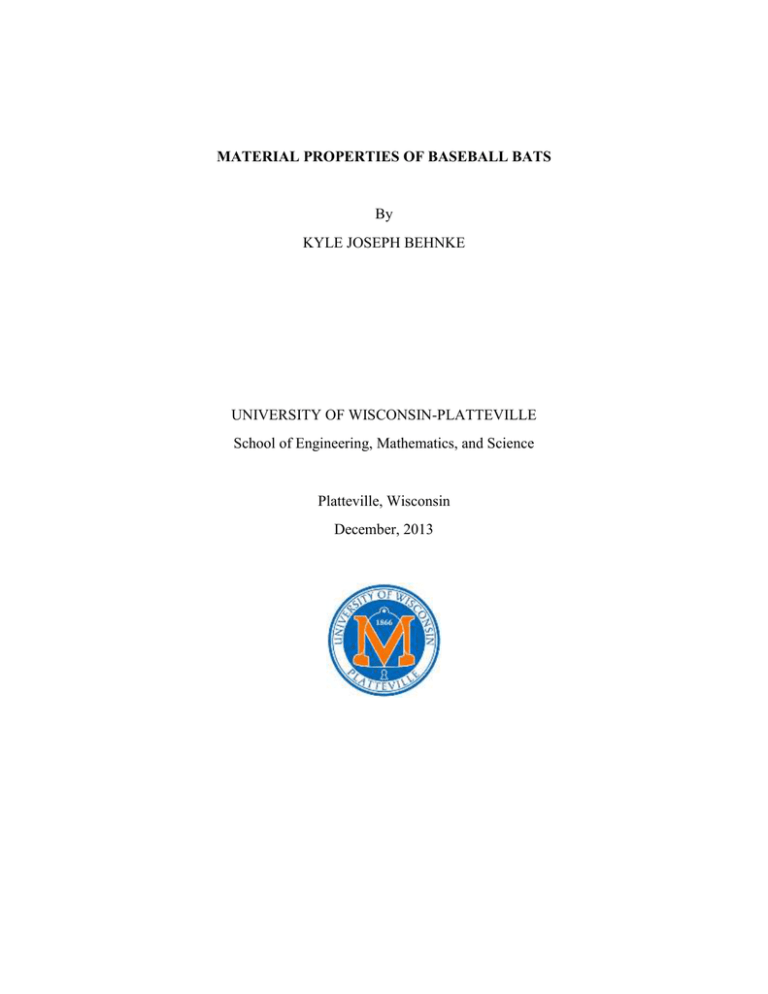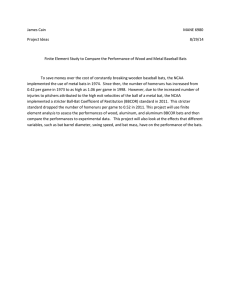Material Properties of Baseball Bats
advertisement

MATERIAL PROPERTIES OF BASEBALL BATS By KYLE JOSEPH BEHNKE UNIVERSITY OF WISCONSIN-PLATTEVILLE School of Engineering, Mathematics, and Science Platteville, Wisconsin December, 2013 INTRODUCTION Baseball bats, since the late 19th century when the first Major League pitch was thrown, have primarily been made of wood. Despite wood remaining the standard material used in the Majors today, it has been replaced in college baseball. Introduced in 1974, metal bats, made from zirconium, copper, magnesium, and aluminum, became the standard in college baseball [1]. After the initial launch of the metal bat, manufacturers battled for market dominance by constantly trying to improve their bat’s performance. Manufacturers soon found the solution by combining several materials to create a composite. The performance difference between metal and wood bats can be explained through their mechanical design, microstructures, material properties, processing, and failure modes. 1 MECHANICAL DESIGN The vast amount of energy held by a pitched ball is evident in the spin and speed of the ball. Solid wood bats dampen much of that energy because the ball compresses on impact. The speed of the batted ball is positively correlated with the amount of energy transferred from the contact with the bat. With hollow-core aluminum bats, the thin walls flex slightly, the ball compresses less, its pitched energy is retained, and more energy is added to the ball leaving the hitting zone. Therefore, metal bats create a higher exit velocity on the same pitch and swing than those of wooden bats. The goal in a metal bat is to make the walls as thin as possible to get the most rebound [2]. An experiment was setup by releasing a baseball from a fixed height onto the different types of baseball bats and calculating the energy loss from the collision. The coefficient of restitution, a measurement for energy retained during impact, for wood was found to be 0.496 and a metal bat to be 0.587 [3]. In wood bats, the moment of inertia is higher because more of the mass is located farther away from the handle, which means the bat swing will move through the hitting zone at a slower rate. The moment of inertia is less in metal bats than in wooden bats, implying the bat will be capable of maneuvering through the hitting zone easier [4]. There’s a higher probability that the baseball will leave the bat with a faster exit velocity if it has a larger coefficient of restitution and lower moment of inertia. Therefore, increasing the chance of getting through the infield without impedance from the defensive players. 2 MICROSTRUCTURES Figure 1. The microstructure of wood (left) and microstructure of aluminum (right). Grain boundary area plays a major role in dislocation motion and strength of the material. The differences between wood and aluminum materials begin at the micro-level. Figure 1 above shows the major differences in the microstructure of wood (left) and aluminum (right). Wood is made up of tracheid and ray cells, which have a large cross-sectional area and thin walls [5]. Aluminum shows a microstructure that has very fine grains [6]. Finer grains have more barriers to prohibit dislocation motion and makes the material stronger. Aluminum is made up of several alloys, which can change the microstructure from one combination to another. The crystal structure of aluminum is a Face Centered Cube. In comparison to most common structures, FCC, as shown in Figure 2, is the most densely packed, and therefore, has a higher planar and linear density of atoms. 3 Figure 2. The crystal structure of aluminum, Face Centered Cubic. Atoms are located at each corner as well as the center of each face. Wood’s major chemical component of the fiber wall is cellulose, which makes up 45% of its weight. As a natural polymer, wood is made up of linear chains of cellulose, as shown below in Figure 3 [7]. The strength of the material is dependent upon how linear the chains are structured. In the case of cellulose, the linear chains will stack easily, implying the material is not as strong. Figure 3. The structure of cellulose, a major chemical component of wood. The linearity of the chains determine the strength. Grains form along the length of a wooden bat because wood is a natural composite. Failure of the wood on impact is directly related to the orientation of the grains against the baseball. Awareness that the bat’s trademark is printed on the grain influences the batter’s bat position, ensuring they hit against the grain. Hitting against the grain, the hardest surface, allows for better performance and a lower chance of failure to occur. Comparing wood and aluminum on the microstructure level has concluded that aluminum performs better than wood. A look at the material properties of these two elements will support this theory further. The material properties follow suit with the microstructures, and this statement holds true because material properties are dependent on how the material is structured. 4 MATERIAL PROPERTIES The material properties between wood and aluminum range broadly. For a common wooden bat, ash, the modulus of elasticity, E, is 13.9 GPa. An aluminum bat’s E is 70.5 GPa [8]. The modulus of elasticity is the slope of the linear portion on the stress-strain curve. A higher slope suggests the material will be able to handle more stress without impacting the elongation. Figure 4 below shows the stress-strain curves for wood and aluminum. Metals typically form a cup-cone shape after the maximum stress load is applied, resulting in a negative sloped curve past the point where the tangent line equals zero. That point is also the location of the ultimate strength. However, for wood, this shape does not appear. After reaching the ultimate stress load, wood will fail, and does not form a cup-cone shape. The material properties support the theory that metal bats outperform wooden bats. Both types of bats flex during contact with the ball but the hollow aluminum bats flex more. This flexing difference allows for a longer contact time, sending more energy to the ball instead of absorbing the pitch’s energy. ALUMINUM WOOD = 13.9 GPa E = 70.5 GPa Figure 4. Typical shape of the stress-strain curve for wood (left) and aluminum (right). The failure occurs in wood prior to necking, whereas in aluminum, a cup-cone shape forms prior to failure. 5 PROCESSING Heat treating is a process used to alter the physical and chemical properties of a material. Heat treatment plays a key role in the finished product of a metal bat. The method to harden the aluminum involves a molten salt bath solution. The metal is heated to nearly 900° F and held at this temperature for 20 minutes. This high temperature causes the various elements that make up the alloy to become soluble and to go into solution, similar to salt dissolving in water. After all of the elements have gone into the solution, the bats are quenched in a water tank. The quenching creates a supersaturated solution that prepares the bats for precipitation aging. To complete the hardening process, the bats are heated in an aging furnace for 12 hours at 300° F. This causes some of the alloying elements to precipitate out of solution. These precipitates form grains in a particular size and shape, thus producing a harder and stronger material. For wood, few processes can be done to make the material stronger. The old fashioned way is bone rubbing over the wood to harden it and prevent flaking. Now the bats will go through a compression machine that provides pressure, heat, and friction in a deeper and more consistent manner, creating a harder bat [9]. The limitations for material processing of wood makes it difficult for wood to be comparable to metal. Finding new processes to make stronger bats is constantly occurring. A new and improved design is one of the few ways to get ahead in a competitive engineering field. 6 FAILURE MODES AND EFFECTS ANALYSIS The microstructure and processing of a material not only affects the material properties and performance, but also the way a material will fail. Figure 5 shows how a wood bat fails. The failure occurs when the grain is close to the handle because this is the weakest spot of the material. Wood can fail on the Figure 5. Failure in a wood bat typically occurs at the weakest point of the bat, with the grain. first batted ball or never fail at all. In the instance shown below, contact was made at the end of the barrel, missing the sweet spot of the bat, and caused too much stress to allocate throughout the bat. The stress was too high for the material to handle, and caused failure. As shown in Figure 6, the end of the bat deformed because it could not handle the kinetic energy being transferred from an 85mph fastball. Metal bats Figure 6. Deformation occurred at the end of the bat because the stress of the pitch was too high for the material to handle. on the other hand, fail in a different way, as seen in Figure 7. This bat has been impacted repeatedly by balls that caused stress on the material. After a certain amount of cycles, the stress necessary to cause failure decreased, and the bat failed due to fatigue. In the case shown, a crack was initiated, and the bat continued to be used. Throughout further use, the crack propagated and eventually led to final failure. A metal typically fails where the location of the stress is applied, making the 7 Figure 7. Metal bat failure. The crack initiated from fatigue, and later propagated to a longer length up until final failure. location of the crack predicable. This can be seen in a torsion test of any metal, the failure occurs where the supports were located. The microstructure again determined how a material will perform and reacts to stresses. The effects from the failure modes are purely a safety issue. Metal bats do not pose a safety concern because the material stays intact, only a crack occurs. However, for wood, a failure may result in a bat shattering sharp edged wood pieces flying throughout the playing field and into the stands. Wood failure is not as predictable as a metal. The timing and location of failure can be random. Given three identical wooden bats making the same contact off of the same pitch may have different results. There could be no failure, the bat could have a small crack or it may completely shatter. 8 SUMMARY Looking at mechanical design, microstructures, material properties, processing, and failure modes, metal bats outperform wood bats in all categories. The hollow core of the aluminum bat allows for more flexing and longer contact times with the pitched ball. Metal bats outperform wood bats because it all comes down to the microstructure. The finer grains in the aluminum have more dislocation barriers, and makes the material stronger. The development of the stressstrain curve and the properties that come off of it favor aluminum. A higher modulus of elasticity and the ability of metal to handle stress after elongating past the ultimate strength point is the reason metal does not fail as frequently as wood. Heat treatment processes are more available to metal, whereas wood is restricted in ways to be strengthened. With all this being stated, aluminum bats outperform wood bats. 9 BIBLIOGRAPHY [1] Onkst, Timothy. “College Baseball Bats.” Live Strong. 2011 [2] Lutz, Diana. “Less Lively Aluminum Baseball Bats Change Game.” Washington University Newsroom. 2012 [3] Raabe, Margaret. “Comparing the Performance of Baseball Bats.” The College of Wooster, Physics. 2011 [4] Pavlovich, Lou. “Physicist Discussion on BBCOR Bats.” College Baseball Newspaper. 2010 [5] Harrington, JJ. “Mechanical Modeling of Wood Microstructure, an Engineering Approach.” IPENZ Transactions. 1997 [6] Zhang, YM. “Improved Microstructure and Properties of 6061 Aluminum Alloys.” Metallurgical and Material Transactions. 2000 [7] Sjostrom, Eli. “Wood Chemistry: Fundamentals and Applications.” Second Edition. San Diego Academic Press. 1993 [8] Mahesh, Shenoy. “Performance Assessment of Wood, Metal, and Composite Baseball Bats.” Elsevier. 2001 [9] Miller, Stuart. “Building a Better Bat.” New York Times. 2013 10




